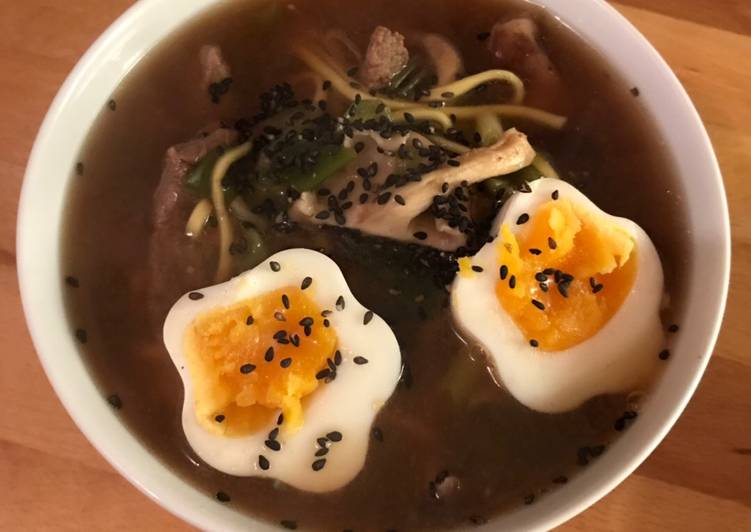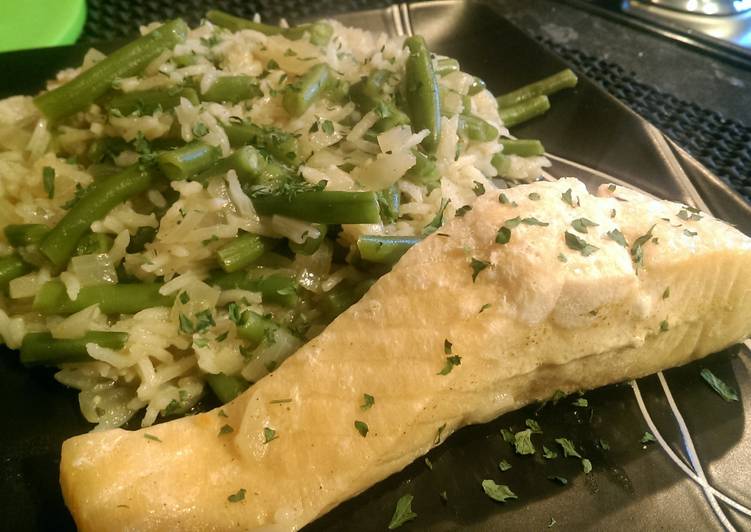
Hey everyone, I hope you’re having an amazing day today. Today, we’re going to make a distinctive dish, beef ramen with ajitsuke tomago. It is one of my favorites food recipes. This time, I will make it a bit unique. This will be really delicious.
Beef ramen with ajitsuke tomago is one of the most favored of recent trending meals in the world. It is enjoyed by millions every day. It is easy, it is quick, it tastes delicious. Beef ramen with ajitsuke tomago is something that I have loved my entire life. They are nice and they look fantastic.
Jammy Ramen Eggs (Ajitsuke Tamago) - These are sweet, salty and rich with plenty of umami flavor. Sweet, salty and rich with plenty of umami flavor - these jammy Ramen Eggs (Ajitsuke Tamago) are simple, versatile and perfect in your ramen bowl, or any other way you eat. The key to ramen eggs (known in Japanese as ajitsuke tamago 味付け卵) is that they aren't just flavoured by their marinade.
To begin with this recipe, we have to first prepare a few components. You can cook beef ramen with ajitsuke tomago using 14 ingredients and 9 steps. Here is how you cook it.
The ingredients needed to make Beef ramen with ajitsuke tomago:
- Get 2 nests of ramen egg noodles
- Prepare 150 g frying steak
- Prepare 500 ml chicken stock
- Get 1 sheet Dashi seaweed
- Take 2 teaspoons miso paste
- Take 2 ajitsuke tomago (Japanese pickled eggs pre-made per other recipe)
- Prepare 1 small chunk of diced ginger
- Prepare 1 tablespoon soy sauce
- Take 200 g shiitake mushrooms
- Take 4 spring onions chopped
- Prepare 100 g baby spinach
- Get Sprinkle of black sesame seeds (optional)
- Get Sprinkle of dried tuna flakes (optional)
- Make ready 1 tablespoon sesame oil
Luxuriously gelatinous yolks of the ramen egg, aka ajitsuke tamago, are worth getting excited over. They add a firmer texture and seasoning to the whites, as well as mamking the yolks much more mesmerizing and jammy. Ajitsuke Tamago (味付け卵), better known as ramen eggs, are first soft-boiled before being marinated in a sweet and savory broth. These flavorful soft-boiled eggs used as a ramen topping are called Ajitsuke Tamago (味付け卵) in Japan, which literally means "seasoned egg." Spicy Taiwanese Beef Ramen.
Instructions to make Beef ramen with ajitsuke tomago:
- Prepare dashi (seaweed stock) per packet instructions. Mine involved wiping clean the seaweed, soaking it in 3.5 cups of water and refrigerating for 6 hours or so. Then slowly heating seaweed and water to just boiling and discarding the seaweed. Using dashi in a later step.
- Chop steak and vegetables as desired
- In a new pan, slowly cook chicken stock until simmering/ softly boiling.
- Fry beef in sesame oil and soy sauce with ginger in a separate pan
- Add vegetables to steak (set some spring onion aside if you want some crunchy vegetables as a topping later)
- Mix miso paste with 150 ml boiling water and add to pan of chicken stock. Also add dashi made in step one.
- Add noodles to boil for 3 to 4 minutes in stock pan. Add steak and vegetables to stock pan. Add baby spinach. Cook together until noodles are tender.
- Remove ajitsuke tomago from moulds and slice in half if desired
- Serve ramen broth into bowls. Add ajitsuke tomago, black sesame seeds, dried tuna flakes, fresh spring onion and herbs as desired. Season with salt and pepper if necessary.
The Ramen egg recipe or Ajjtsuke Tamago according to the Korean-style is easy to make. The secret lies in Ramen sauce with soft-boiled eggs. It is too yummy when served with rice or noodles. The taste is strong and tasty enough to mingle with the noodle soup or the plain fragrant rice. Slight salty, sweet and packed with umami goodness, these jammy, soft boiled Ramen Eggs are what life is all about.
So that’s going to wrap it up for this special food beef ramen with ajitsuke tomago recipe. Thank you very much for reading. I am confident you will make this at home. There’s gonna be interesting food in home recipes coming up. Don’t forget to bookmark this page on your browser, and share it to your loved ones, friends and colleague. Thanks again for reading. Go on get cooking!


